Saturday, July 29, 2006
McCain races to solve tribal funds dispute
McCain races to solve tribal funds disputeBilly House Republic Washington Bureau Jul. 28, 2006 12:00 AMWASHINGTON - The next few days may be Sen. John McCain's last best opportunity to resolve 10-year-old litigation against the federal government over billions of dollars in mineral royalties and land leases long denied to Native American landowners.With time running out on the congressional
Thursday, July 20, 2006
Art Nouveau Stickpins
Collection of Art Nouveau, Art Deco, and Edwardian stickpins, look for these added to the “For Sale” post, scale in centimeters.
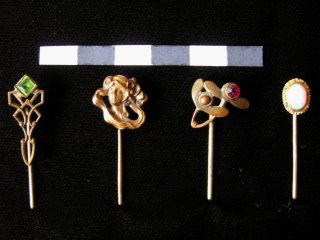
Gilt metal stickpin with Art Nouveau woman with flowing hair. Excellent condition. Price: $75
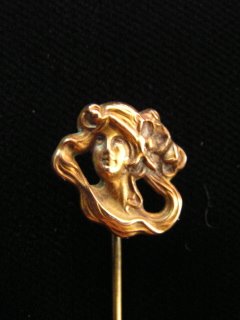
Great organic design Art Nouveau stickpin with red paste stone and nice patina. Very good condition, pin slightly bent. Price: $45
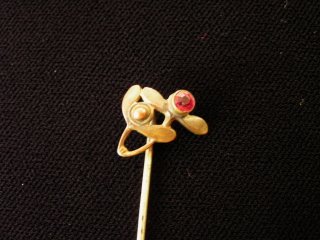
Beautiful Art Deco stickpin with a great design, green paste stone, and nice patina. Excellent condition. Price: $50

This Edwardian stickpin is too pretty not to include in this post. It is crafted from high karat gold with a nice deep hand tooling design and high quality opal. I’m keeping this one.
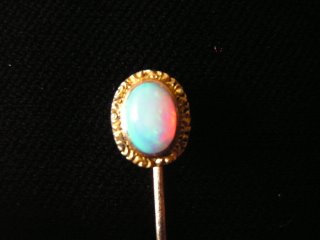

Gilt metal stickpin with Art Nouveau woman with flowing hair. Excellent condition. Price: $75

Great organic design Art Nouveau stickpin with red paste stone and nice patina. Very good condition, pin slightly bent. Price: $45

Beautiful Art Deco stickpin with a great design, green paste stone, and nice patina. Excellent condition. Price: $50

This Edwardian stickpin is too pretty not to include in this post. It is crafted from high karat gold with a nice deep hand tooling design and high quality opal. I’m keeping this one.

Art Nouveau Stickpins
Collection of Art Nouveau, Art Deco, and Edwardian stickpins, look for these added to the “For Sale” post, scale in centimeters.

Gilt metal stickpin with Art Nouveau woman with flowing hair. Excellent condition. Price: $75

Great organic design Art Nouveau stickpin with red paste stone and nice patina. Very good condition, pin slightly bent. Price: $45

Beautiful Art Deco stickpin with a great design, green paste stone, and nice patina. Excellent condition. Price: $50

This Edwardian stickpin is too pretty not to include in this post. It is crafted from high karat gold with a nice deep hand tooling design and high quality opal. I’m keeping this one.


Gilt metal stickpin with Art Nouveau woman with flowing hair. Excellent condition. Price: $75

Great organic design Art Nouveau stickpin with red paste stone and nice patina. Very good condition, pin slightly bent. Price: $45

Beautiful Art Deco stickpin with a great design, green paste stone, and nice patina. Excellent condition. Price: $50

This Edwardian stickpin is too pretty not to include in this post. It is crafted from high karat gold with a nice deep hand tooling design and high quality opal. I’m keeping this one.

Monday, July 17, 2006
Victorian Social Tradition meets Craftsman Socialist Tradition
The best part of traveling to Europe is hanging out in cafes and museums and shopping for sentimental jewelry. In the Victoria and Albert Museum in London, I found this hairwork memorial for William Morris, the Arts and Crafts designer, socialist, and associate of the Pre-Raphaelite Brotherhood.
Gilt memorial plaque designed with flowers, “William Morris 1834 – 1896,” and Morris’ hair.
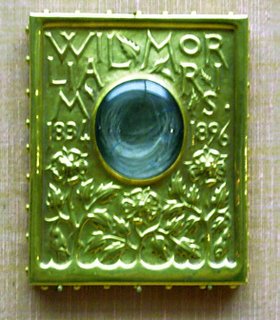
Morris is often remembered today for his wallpaper designs, book printing, poetry, stained glass, commitment to safe and comfortable working conditions for craftsmen (in opposition to the cramped, dangerous factories of industrial mass production) and, of course, the Morris chair, an early recliner popularized by Stickley. Gustav Stickley dedicated the first issue of “The Craftsman Magazine” 1901 to William Morris.
William Morris

Wallpaper design by Morris

Gilt memorial plaque designed with flowers, “William Morris 1834 – 1896,” and Morris’ hair.

Morris is often remembered today for his wallpaper designs, book printing, poetry, stained glass, commitment to safe and comfortable working conditions for craftsmen (in opposition to the cramped, dangerous factories of industrial mass production) and, of course, the Morris chair, an early recliner popularized by Stickley. Gustav Stickley dedicated the first issue of “The Craftsman Magazine” 1901 to William Morris.
William Morris

Wallpaper design by Morris

Victorian Social Tradition meets Craftsman Socialist Tradition
The best part of traveling to Europe is hanging out in cafes and museums and shopping for sentimental jewelry. In the Victoria and Albert Museum in London, I found this hairwork memorial for William Morris, the Arts and Crafts designer, socialist, and associate of the Pre-Raphaelite Brotherhood.
Gilt memorial plaque designed with flowers, “William Morris 1834 – 1896,” and Morris’ hair.

Morris is often remembered today for his wallpaper designs, book printing, poetry, stained glass, commitment to safe and comfortable working conditions for craftsmen (in opposition to the cramped, dangerous factories of industrial mass production) and, of course, the Morris chair, an early recliner popularized by Stickley. Gustav Stickley dedicated the first issue of “The Craftsman Magazine” 1901 to William Morris.
William Morris

Wallpaper design by Morris

Gilt memorial plaque designed with flowers, “William Morris 1834 – 1896,” and Morris’ hair.

Morris is often remembered today for his wallpaper designs, book printing, poetry, stained glass, commitment to safe and comfortable working conditions for craftsmen (in opposition to the cramped, dangerous factories of industrial mass production) and, of course, the Morris chair, an early recliner popularized by Stickley. Gustav Stickley dedicated the first issue of “The Craftsman Magazine” 1901 to William Morris.
William Morris

Wallpaper design by Morris

Saturday, July 15, 2006
French Hairwork Plaque
This is one of my favorite pieces of sentimental jewelry from my personal collection. The temple of love constructed entirely from human hair contains the inscription “la tendresse nous unit” or “tenderness units us.” The dog symbolizes fidelity. Atop the altar, the five hearts metonymically represent five actual individuals, who are crowned by two birds symbolizing love and intimacy. The evergreens symbolize constancy, and the pansy, a common symbol in sentimental art, means “think of me.” These symbols unite to form an allegory emphasizing the pledge of a family and/or friends to remain tenderly devoted to each other – a pledge both embodied and reified by a class-marking artifact. Scale in centimeters.
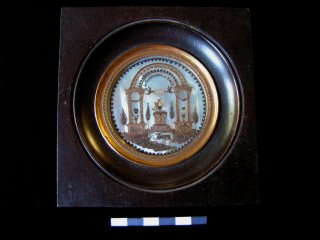



French Hairwork Plaque
This is one of my favorite pieces of sentimental jewelry from my personal collection. The temple of love constructed entirely from human hair contains the inscription “la tendresse nous unit” or “tenderness units us.” The dog symbolizes fidelity. Atop the altar, the five hearts metonymically represent five actual individuals, who are crowned by two birds symbolizing love and intimacy. The evergreens symbolize constancy, and the pansy, a common symbol in sentimental art, means “think of me.” These symbols unite to form an allegory emphasizing the pledge of a family and/or friends to remain tenderly devoted to each other – a pledge both embodied and reified by a class-marking artifact. Scale in centimeters.




Wednesday, July 12, 2006
14K White Gold Diamond Earrings
Every woman loves to dazzle and diamond earrings are just the accessories to make it happen. Perhaps the most classic design is a simple diamond stud, but there are also creations in chandelier, hoops, stick bar and dangle diamond earrings. In recent years, there have even been diamond earpins produced for the woman who wants to make a truly unique statement in fashion.14K White Gold 3/8ct
Navajo Nation fires 15 after Head Start background checks
Arizona / WestNavajo Nation fires 15 after Head Start background checksThe Associated PressTucson, Arizona Published: 07.12.2006WINDOW ROCK — The Navajo Nation has fired 15 employees from its troubled Head Start program after doing background checks.Federal funding for the tribe's Head Start program was suspended May 2 by the Administration for Children and Families, which said the tribe failed
Monday, July 10, 2006
Photographic Jewelry
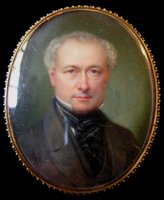 The story of photographic jewelry is also the story of the end of portrait miniatures. The invention of Daguerreotype photography in 1838 caused a decline in portrait miniature production after 1840 and a very sharp decline after 1850. Indeed, in 1865 the South Kensington Museum, later the Victoria and Albert Museum, in London held the first major museum exhibition of 4000 portrait miniatures. In the last half of the nineteenth century, portrait miniatures were less likely to be commissioned and more likely to be the domain of the antique collector and museum curator.
The story of photographic jewelry is also the story of the end of portrait miniatures. The invention of Daguerreotype photography in 1838 caused a decline in portrait miniature production after 1840 and a very sharp decline after 1850. Indeed, in 1865 the South Kensington Museum, later the Victoria and Albert Museum, in London held the first major museum exhibition of 4000 portrait miniatures. In the last half of the nineteenth century, portrait miniatures were less likely to be commissioned and more likely to be the domain of the antique collector and museum curator. Photographs were less expensive than miniatures and continued to become increasingly less expensive as the nineteenth century progressed. “Pictures drawn by the sun,” as they were sometimes called, were also perceived to be more accurate likenesses than portrait miniatures. However, like miniatures, photographs were frequently housed in jewelry and augmented with hairwork. By the conclusion of World War I, the addition of hairwork came to an end.
Photographic revolving brooch, circa 1865, with palette worked hair on the reverse.

The photographs were occasionally painted to add color to the skin and details of the dress. Painted photographic revolving brooch, circa 1850s, with black enamel and hairwork reverse.
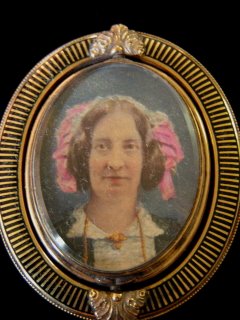

In the 1860s several French photographers began enameling their photographs in order to have a long lasting colored photograph that would not fade. The enamel miniature below was created by Lafon de Camarsac c. 1870 of a Parisian woman wearing Irish crochet lace adornment.

The albumen print portrait below, c. 1870, was taken in the studio of Mathieu Deroche and provides an example of the work from the other master of enamel photography working in Paris at the same time.

A very few portrait miniaturists, like John Henry Brown and John Wood Dodge, were successfully able to continue producing miniatures after 1860 by painting in a glossy, photo-realistic manner. This finely detailed portrait miniature on ivory was painted circa 1880 by John Henry Brown (1818-1891) and housed in a bracelet clasp.


Colored photographic locket, circa 1890s, with hair on the reverse.


Colored photographic locket, circa 1900s, with basket weave hairwork reverse.
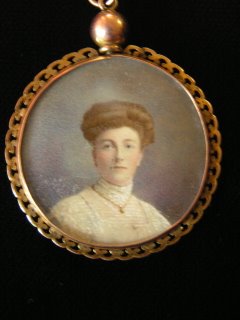
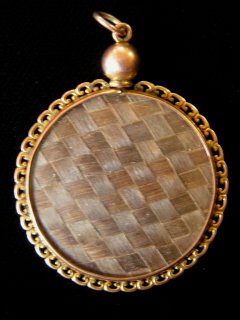
By the early twentiety century, artists began a brief revival of portrait and eye miniatures. This portrait miniature by Frederick Boyd Waters (Canadian 1879-1967) watercolor on ivory, c. 1920, displays an influence from the craftsman renaissance of the same period.

Photographic Jewelry
 The story of photographic jewelry is also the story of the end of portrait miniatures. The invention of Daguerreotype photography in 1838 caused a decline in portrait miniature production after 1840 and a very sharp decline after 1850. Indeed, in 1865 the South Kensington Museum, later the Victoria and Albert Museum, in London held the first major museum exhibition of 4000 portrait miniatures. In the last half of the nineteenth century, portrait miniatures were less likely to be commissioned and more likely to be the domain of the antique collector and museum curator.
The story of photographic jewelry is also the story of the end of portrait miniatures. The invention of Daguerreotype photography in 1838 caused a decline in portrait miniature production after 1840 and a very sharp decline after 1850. Indeed, in 1865 the South Kensington Museum, later the Victoria and Albert Museum, in London held the first major museum exhibition of 4000 portrait miniatures. In the last half of the nineteenth century, portrait miniatures were less likely to be commissioned and more likely to be the domain of the antique collector and museum curator. Photographs were less expensive than miniatures and continued to become increasingly less expensive as the nineteenth century progressed. “Pictures drawn by the sun,” as they were sometimes called, were also perceived to be more accurate likenesses than portrait miniatures. However, like miniatures, photographs were frequently housed in jewelry and augmented with hairwork. By the conclusion of World War I, the addition of hairwork came to an end.
Photographic revolving brooch, circa 1865, with palette worked hair on the reverse.

The photographs were occasionally painted to add color to the skin and details of the dress. Painted photographic revolving brooch, circa 1850s, with black enamel and hairwork reverse.


In the 1860s several French photographers began enameling their photographs in order to have a long lasting colored photograph that would not fade. The enamel miniature below was created by Lafon de Camarsac c. 1870 of a Parisian woman wearing Irish crochet lace adornment.

The albumen print portrait below, c. 1870, was taken in the studio of Mathieu Deroche and provides an example of the work from the other master of enamel photography working in Paris at the same time.

A very few portrait miniaturists, like John Henry Brown and John Wood Dodge, were successfully able to continue producing miniatures after 1860 by painting in a glossy, photo-realistic manner. This finely detailed portrait miniature on ivory was painted circa 1880 by John Henry Brown (1818-1891) and housed in a bracelet clasp.


Colored photographic locket, circa 1890s, with hair on the reverse.


Colored photographic locket, circa 1900s, with basket weave hairwork reverse.


By the early twentiety century, artists began a brief revival of portrait and eye miniatures. This portrait miniature by Frederick Boyd Waters (Canadian 1879-1967) watercolor on ivory, c. 1920, displays an influence from the craftsman renaissance of the same period.

Saturday, July 1, 2006
Portrait Miniatures
“We heard the turning of a key in a small lock; she has opened a secret drawer of an escritoire, and is probably looking at a certain miniature, done in Malbone’s most perfect style, and representing a face worthy of no less delicate a pencil. It was once our good fortune to see this picture. It is the likeness of a young man, in a silken dressing-gown of an old fashion, the soft richness of which is well adapted to the countenance of reverie, with its full, tender lips, and beautiful eyes, that seem to indicate not as much capacity of thought, as gentle and voluptuous emotion”
– Nathaniel Hawthorne, 1851
Portrait miniatures were intensely intimate objects that linked together the sitter, viewer, and wearer and communicated their relationship to one another. The potent reverential symbolism of miniatures was well understood by portrait miniaturists. For example, Charles Fraser in his eulogy for fellow miniaturist, Edward Greene Malbone, lauded, “He imparted such life to the ivory, and produced such striking resemblances, that they will never fail to perpetuate the tenderness of friendship, to divert the care of absence, and to aid affection in dwelling on those features and that image, which death has forever wrested in it.”
Portrait miniature on ivory by Thomas Hazelhurst, signed “T.H.” The reverse features basket weave hairwork surrounded by translucent blue enamel and backed with embossed foil. Scale in centimeters.
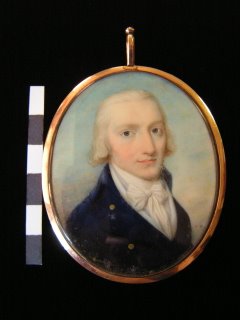
English portrait miniature with dark blue silk moire on the reverse.
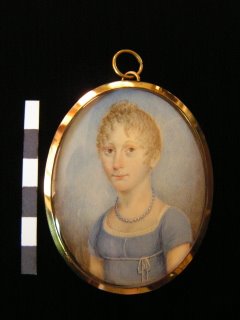
English portrait miniature on ivory…

With a palette worked curl and blue enamel initial plaque on the reverse.
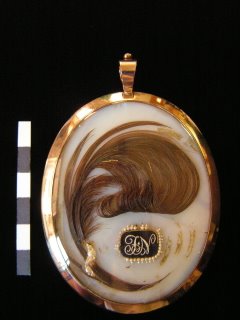
Portrait miniature on ivory signed “E. Taylor 1827” along the right edge. In addition to miniature painting, Taylor was also a jeweler and probably crafted the silver brooch with a black enamel band specifically for this miniature.

On the reverse, a palette worked curl on black fabric.

French portrait miniature by Jean-Baptiste Soyer, the reverse of which houses the most incredible hairwork I’ve ever seen: a family of birds nesting among three sheaths of wheat.
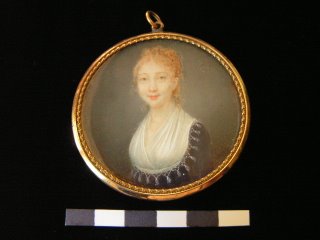

The sheath of wheat was a popular symbol for prosperity and fecundity, and the two brooches below represent hairwork wheat framed by laurels.
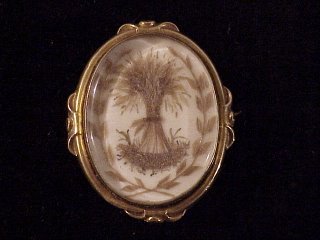

Happiness
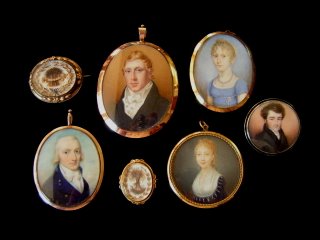
– Nathaniel Hawthorne, 1851
Portrait miniatures were intensely intimate objects that linked together the sitter, viewer, and wearer and communicated their relationship to one another. The potent reverential symbolism of miniatures was well understood by portrait miniaturists. For example, Charles Fraser in his eulogy for fellow miniaturist, Edward Greene Malbone, lauded, “He imparted such life to the ivory, and produced such striking resemblances, that they will never fail to perpetuate the tenderness of friendship, to divert the care of absence, and to aid affection in dwelling on those features and that image, which death has forever wrested in it.”
Portrait miniature on ivory by Thomas Hazelhurst, signed “T.H.” The reverse features basket weave hairwork surrounded by translucent blue enamel and backed with embossed foil. Scale in centimeters.

English portrait miniature with dark blue silk moire on the reverse.

English portrait miniature on ivory…

With a palette worked curl and blue enamel initial plaque on the reverse.

Portrait miniature on ivory signed “E. Taylor 1827” along the right edge. In addition to miniature painting, Taylor was also a jeweler and probably crafted the silver brooch with a black enamel band specifically for this miniature.

On the reverse, a palette worked curl on black fabric.

French portrait miniature by Jean-Baptiste Soyer, the reverse of which houses the most incredible hairwork I’ve ever seen: a family of birds nesting among three sheaths of wheat.


The sheath of wheat was a popular symbol for prosperity and fecundity, and the two brooches below represent hairwork wheat framed by laurels.


Happiness

Subscribe to:
Posts (Atom)
